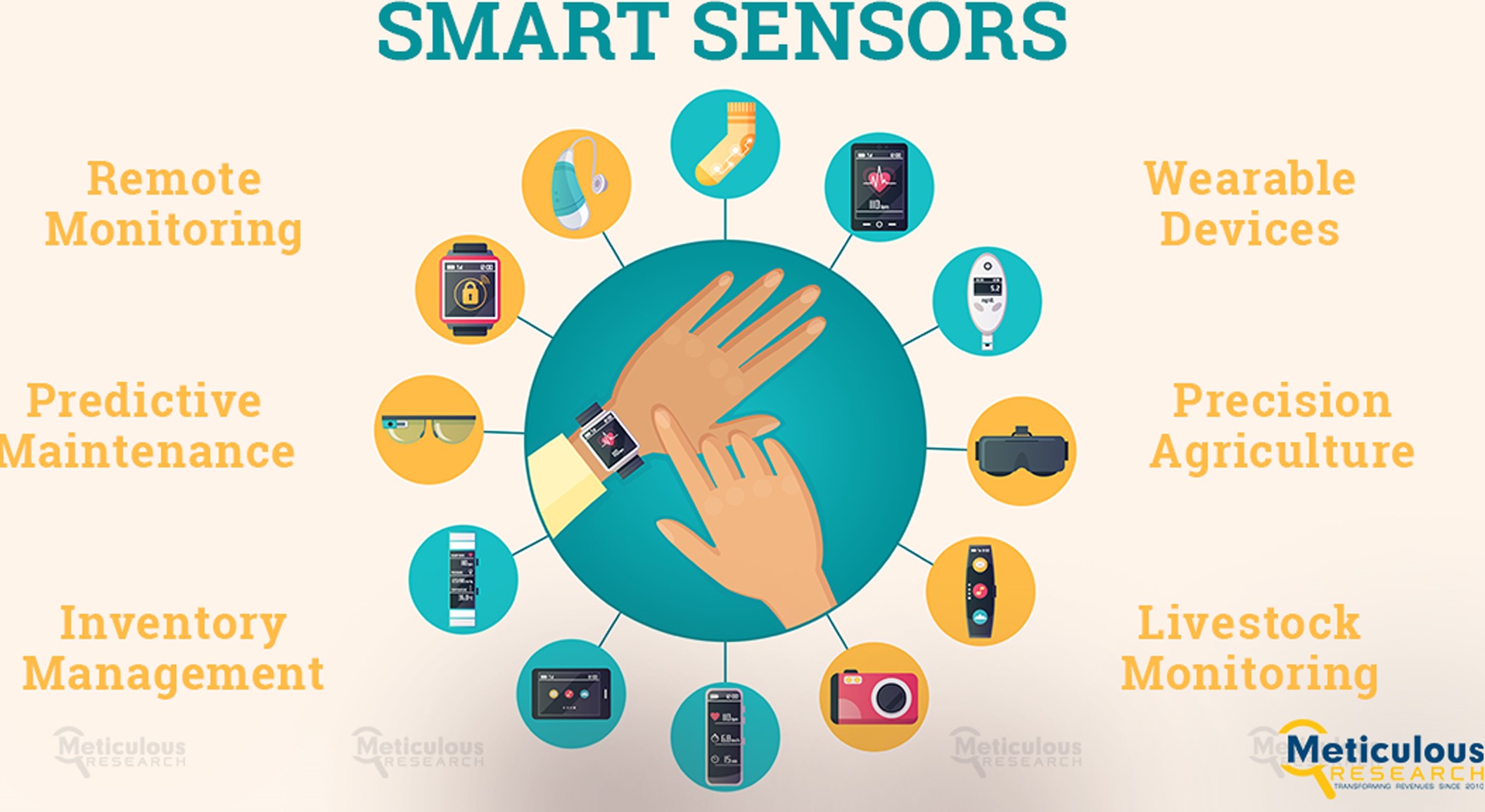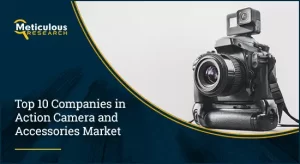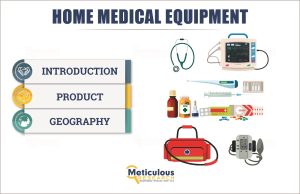
The Smart Sensors Market is projected to reach $137.6 billion by 2030, at a CAGR of 16.3% from 2024 to 2030.
Introduction to the Smart Sensors Market
Meticulous Research®, a leading global market research company, has recently published a comprehensive report titled, ‘Smart Sensors Market by Component (Transceivers, Amplifiers), Technology (Optic, Ultrasonic), Application (Remote Monitoring, Wearable Devices), Sensor Type (Image Sensors, Pressure Sensors), End User (Automotive, Retail, BFSI), and Geography – Global Forecast to 2030.’ According to the report, the global smart sensors market is projected to reach $137.6 billion by 2030, growing at a CAGR of 16.3% from 2024 to 2030.
This market’s growth is primarily driven by the rising demand for smart sensors in IoT-based devices, an increasing need for sensor-enabled wearable devices, and growing demand from the healthcare and automotive industries. The increasing adoption of consumer electronics and smart sensors for industrial automation offers substantial opportunities for market stakeholders. However, high installation and maintenance costs and concerns regarding regulatory compliance and data security may pose challenges to market growth.
Download Sample Report Here @ https://www.meticulousresearch.com/download-sample-report/cp_id=5709
Market Segmentation by Component
The smart sensors market is segmented based on various components, including analog-to-digital converters, digital-to-analog converters, transceivers, amplifiers, microcontrollers, and other related components. Among these, the analog-to-digital converter segment is anticipated to hold the largest market share in 2024. This is largely due to the increasing need for high accuracy and precision in measurements, the use of embedded processing capabilities to analyze digital data, and the rising demand for battery-powered or energy-efficient smart sensors. Furthermore, the growing popularity of ADC technology, especially for supporting calibration and self-diagnostics, positions this segment for the highest growth rate during the forecast period.
Technology Segment Insights
The smart sensors market is also categorized based on technologies such as microelectronic mechanical systems (MEMS), complementary metal-oxide semiconductors (CMOS), capacitive, doppler, inductance, optic, ultrasonic, and others. MEMS technology is expected to dominate the market by 2024, driven by the need for miniaturization of mechanical components, which allows for the creation of compact and lightweight sensors. MEMS sensors offer high precision and efficiency, making them indispensable in sectors like consumer electronics, automotive, healthcare, and industrial automation. The growing demand for more power-efficient sensors further accelerates the adoption of MEMS technology, which is projected to experience the highest growth rate during the forecast period.
Application-Specific Growth
In terms of application, the smart sensors market covers environmental monitoring, remote monitoring, predictive maintenance, inventory management, and wearable devices, among others. The wearable devices segment is expected to claim the largest market share in 2024, driven by the increasing use of wearables for fitness tracking, health monitoring, and chronic disease management. The application of smart sensors in wearable devices extends to sports, where they are used to track performance, optimize training, and prevent injuries. This segment is projected to grow at the fastest pace during the forecast period, highlighting the expanding role of smart sensors in personalized healthcare and safety applications.
Analysis by Sensor Type
Smart sensors come in various types, including temperature and humidity sensors, pressure sensors, flow sensors, proximity sensors, image sensors, motion and occupancy sensors, water sensors, position sensors, light sensors, and ultrasonic sensors. Image sensors are expected to capture the largest market share by 2024. Their widespread use in enhancing functionality, improving user experiences, and enabling the collection and processing of visual data across various industries has fueled their growth. Image sensors play a crucial role in security and surveillance systems, quality control, and inspection tasks, making them a key contributor to the smart sensors market. This segment is anticipated to exhibit the highest CAGR during the forecast period.
End User Adoption
The smart sensors market is also analyzed based on end users, which include sectors such as manufacturing, agriculture, retail, BFSI, logistics and transportation, aerospace & defense, automotive, biomedical & healthcare, industrial automation, building automation, and consumer electronics. Consumer electronics is expected to account for the largest market share in 2024. The growing integration of smart sensors into consumer electronics for improved functionality, enhanced user experience, and new feature enablement has driven this segment’s growth. The increasing popularity of smart home devices and wearable technologies further supports the market’s expansion. Additionally, this segment is predicted to register the highest growth rate during the forecast period.
Geographical Insights
Geographically, the global smart sensors market is divided into North America, Europe, Asia-Pacific, Latin America, and the Middle East & Africa. In 2024, Asia-Pacific is expected to lead the global smart sensors market, primarily due to rising demand from countries like China, Japan, India, South Korea, and Singapore. The growing adoption of smart sensors for manufacturing optimization, predictive maintenance, and quality control, along with their use in traffic management and healthcare, propels the region’s dominance. Moreover, smart city initiatives in several Asian countries further enhance the market’s growth prospects.
On the other hand, North America is anticipated to register the highest CAGR during the forecast period, driven by the increasing proliferation of smart home devices, wearable technologies, and the deployment of smart sensors in advanced driver assistance systems (ADAS) and self-driving cars. The region’s focus on energy efficiency, security, and convenience in urban planning also accelerates smart sensor adoption across multiple sectors.
Conclusion
The global smart sensors market is on a strong growth trajectory, driven by the increasing adoption of smart technologies across various sectors, including healthcare, automotive, consumer electronics, and industrial automation. While challenges like high installation costs and data security concerns remain, the demand for smart sensors in wearable devices, IoT applications, and smart city projects offers significant growth opportunities. As innovations continue, especially in sensor miniaturization and power efficiency, the smart sensors market is poised for rapid expansion through 2030.
Quick Buy : https://www.meticulousresearch.com/Checkout/78171912
Key Players
The key players operating in the global smart sensors market are Analog Devices, Inc. (U.S.), Infineon Technologies AG (Germany), STMicroelectronics N.V. (Netherlands), Honeywell International Inc. (U.S.), General Electric Company (U.S.), EATON CORPORATION plc (Ireland), Robert Bosch GmbH (Germany), Siemens AG (Germany), ABB Ltd. (Switzerland), NXP SEMICONDUCTORS N.V. (Netherlands), Ambetronics Engineers Pvt. Ltd. (India), RPL Automation Pvt. Ltd. (India), Total Control & Automation Pvt. Ltd. (India), Vighnaharta Technologies Pvt. Ltd. (India), and Ecobee (Canada).
Scope of the Report:
Smart Sensors Market Assessment, by Component
- Analog-to-Digital Converter
- Digital to Analog Converter
- Transceivers
- Amplifiers
- Microcontrollers
- Other Components
Smart Sensors Market Assessment, by Technology
- Micro Electronic Mechanical Systems
- Complementary Metal-Oxide Semiconductor
- Capacitive
- Doppler
- Inductance
- Optic
- Ultrasonic
- Other Technologies
Smart Sensors Market Assessment, by Application
- Environmental Monitoring
- Remote Monitoring
- Predictive Maintenance
- Inventory Management
- Advanced Driver Assistance Systems
- Wearable Devices
- Precision Agriculture
- Livestock Monitoring
- Traffic Monitoring and Controlling
- Building and Infrastructure
- Other Applications
Smart Sensors Market Assessment, by Sensor Type
- Temperature & Humidity Sensors
- Pressure Sensors
- Flow Sensors
- Proximity Sensors
- Image Sensors
- Motion & Occupancy Sensors
- Water Sensors
- Position Sensors
- Light Sensors
- Ultrasonic Sensors
- Other Sensors
Smart Sensors Market Assessment, by End User
- Manufacturing
- Agriculture
- Retail
- BFSI
- Logistics and Transportation
- Aerospace & Defense
- Automotive
- Biomedical & Healthcare
- Industrial Automation
- Building Automation
- Consumer Electronics
- Other End User
Smart Sensors Market Assessment, by Geography
- North America
- U.S.
- Canada
- Europe
- Germany
- U.K.
- France
- Italy
- Spain
- Rest of Europe
- Asia-Pacific
- China
- Japan
- India
- South Korea
- Singapore
- Rest of Asia-Pacific
- Latin America
- Middle East & Africa
About Meticulous Research®
Meticulous Research® is a leading provider of comprehensive market intelligence, offering actionable insights and analysis across various industries. Our reports empower businesses to make informed decisions, drive growth, and remain competitive in a rapidly evolving marketplace.
Contact:
Meticulous Market Research Pvt. Ltd.
1267 Willis St, Ste 200 Redding,
California, 96001, U.S.
USA: +1-646-781-8004
Europe : +44-203-868-8738
APAC: +91 744-7780008
Email- sales@meticulousresearch.com
Visit Our Website: https://www.meticulousresearch.com/
Connect with us on LinkedIn- https://www.linkedin.com/company/meticulous-research







